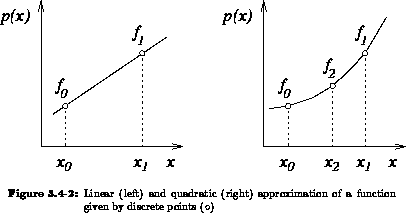3.4.1 Divided Differences




Next: 3.4.2 Fluxes
Up: 3.4 Discretization of the
Previous: 3.4 Discretization of the
Frequently we need an approximation of a function  given at discrete
points
given at discrete
points  . From basic calculus we know that a reasonably smooth function
. From basic calculus we know that a reasonably smooth function
 can be written in a Taylor series expansion with some truncation
term, thus,
can be written in a Taylor series expansion with some truncation
term, thus,  is equal to a polynomial plus a correction term. Divided
differences can be used to compute such a polynomial most elegantly. The
first and second divided differences are defined by
(3.4-1) and (3.4-2), respectively, and in general the
is equal to a polynomial plus a correction term. Divided
differences can be used to compute such a polynomial most elegantly. The
first and second divided differences are defined by
(3.4-1) and (3.4-2), respectively, and in general the
 divided difference is defined by (3.4-3).
divided difference is defined by (3.4-3).



The polynomial approximation  of degree
of degree  of
of  is then given
by (3.4-4) with an error (3.4-5), where
is then given
by (3.4-4) with an error (3.4-5), where  . Note, that the divided difference
. Note, that the divided difference
 is a symmetric function of its
is a symmetric function of its  arguments.
arguments.


As an example we compute the second order polynomial approximation for the
function  whose values at
whose values at  ,
,  and
and  are known to be
are known to be
 ,
,  and
and  , respectively. Using (3.4-4) we get
the approximation (3.4-6).
, respectively. Using (3.4-4) we get
the approximation (3.4-6).

Figure 3.4-2 shows the linear and quadratic approximations
of a function given discrete values.

Martin Stiftinger
Wed Oct 19 13:03:34 MET 1994
 given at discrete
points
given at discrete
points  . From basic calculus we know that a reasonably smooth function
. From basic calculus we know that a reasonably smooth function
 can be written in a Taylor series expansion with some truncation
term, thus,
can be written in a Taylor series expansion with some truncation
term, thus,  is equal to a polynomial plus a correction term. Divided
differences can be used to compute such a polynomial most elegantly. The
first and second divided differences are defined by
(3.4-1) and (3.4-2), respectively, and in general the
is equal to a polynomial plus a correction term. Divided
differences can be used to compute such a polynomial most elegantly. The
first and second divided differences are defined by
(3.4-1) and (3.4-2), respectively, and in general the
 divided difference is defined by (3.4-3).
divided difference is defined by (3.4-3).







 of degree
of degree  of
of  . Note, that the divided difference
. Note, that the divided difference
 is a symmetric function of its
is a symmetric function of its  arguments.
arguments.


 ,
,  and
and  are known to be
are known to be
 ,
,  and
and  , respectively. Using (
, respectively. Using (
